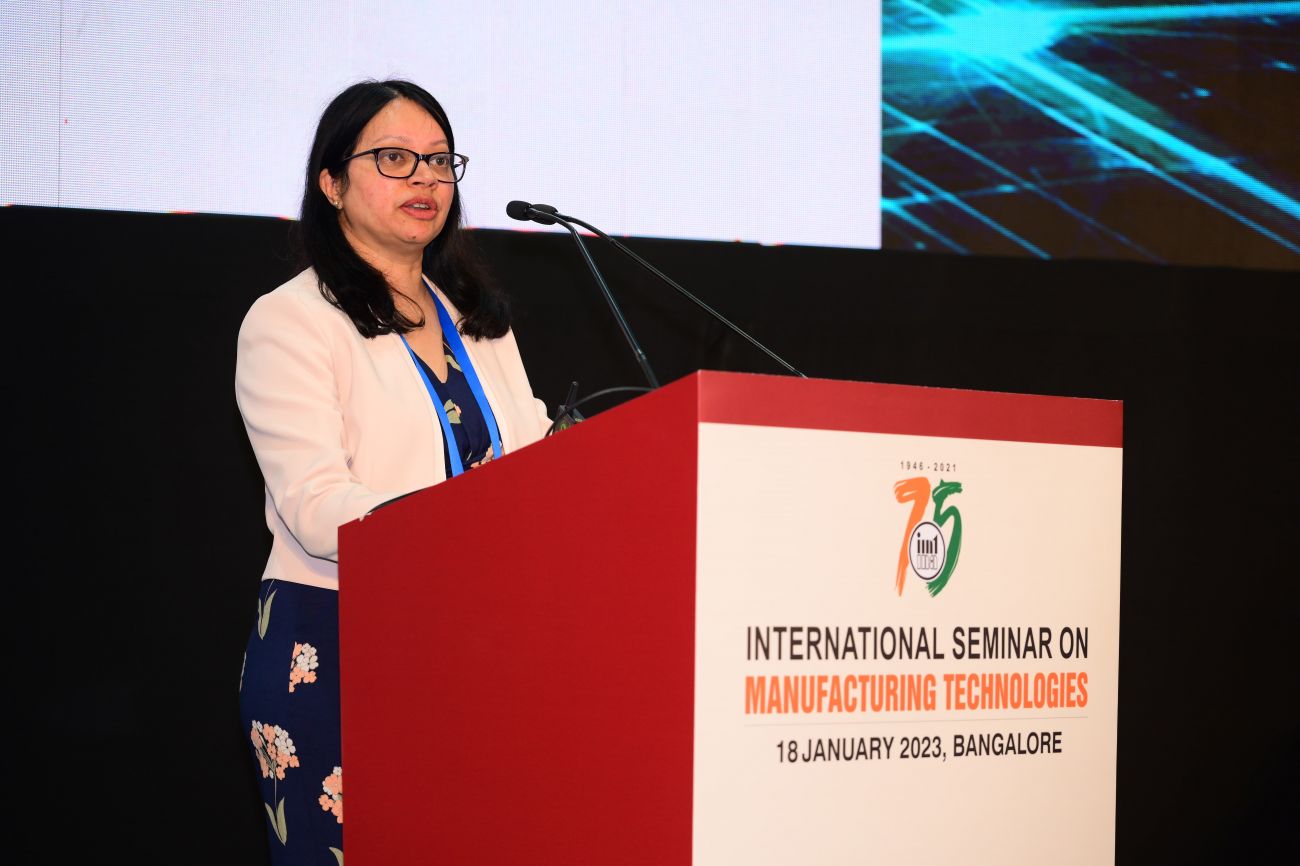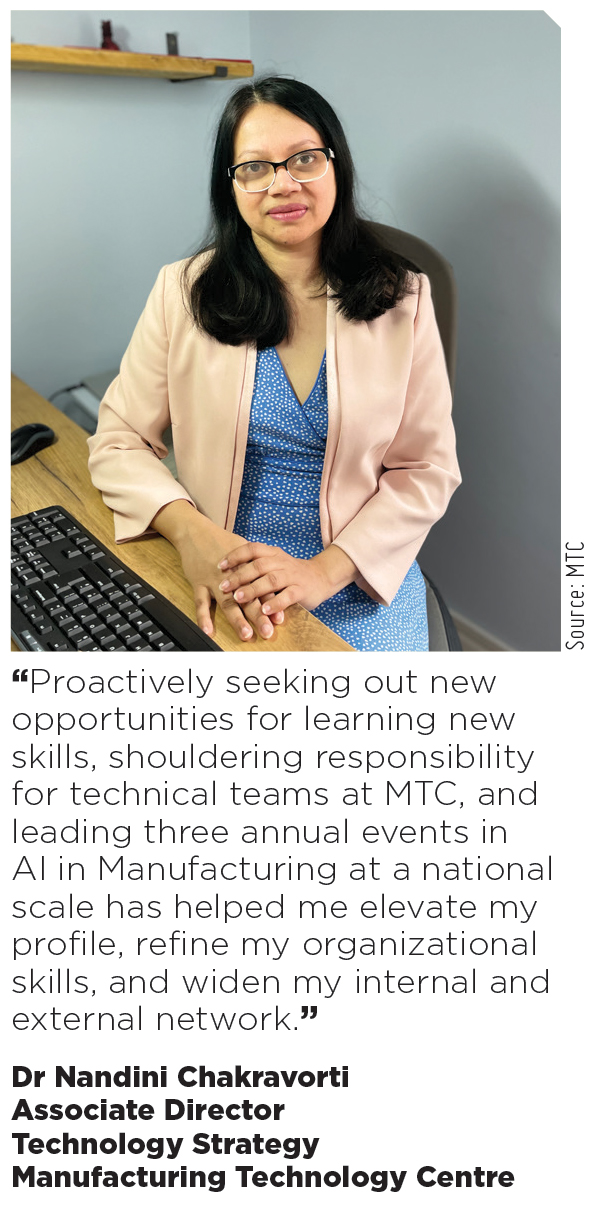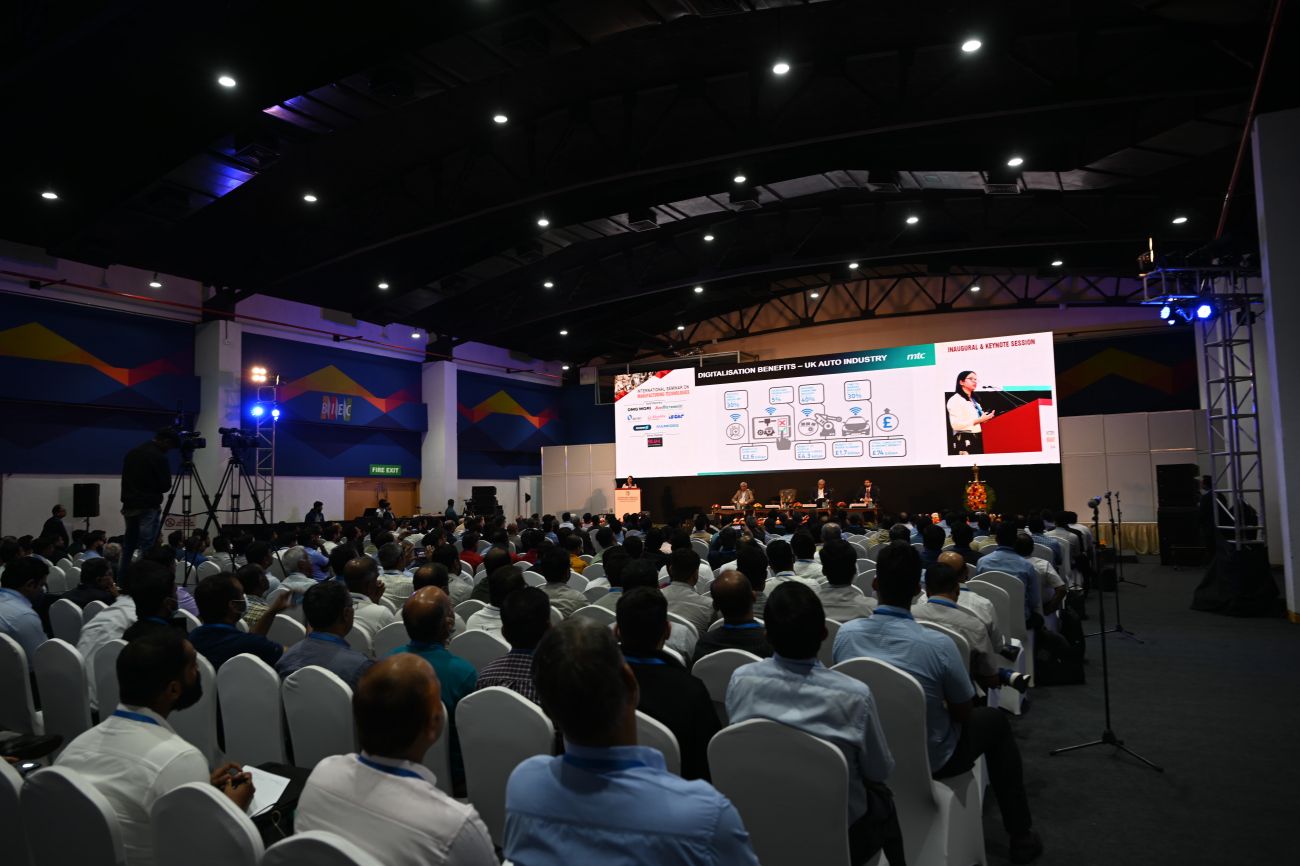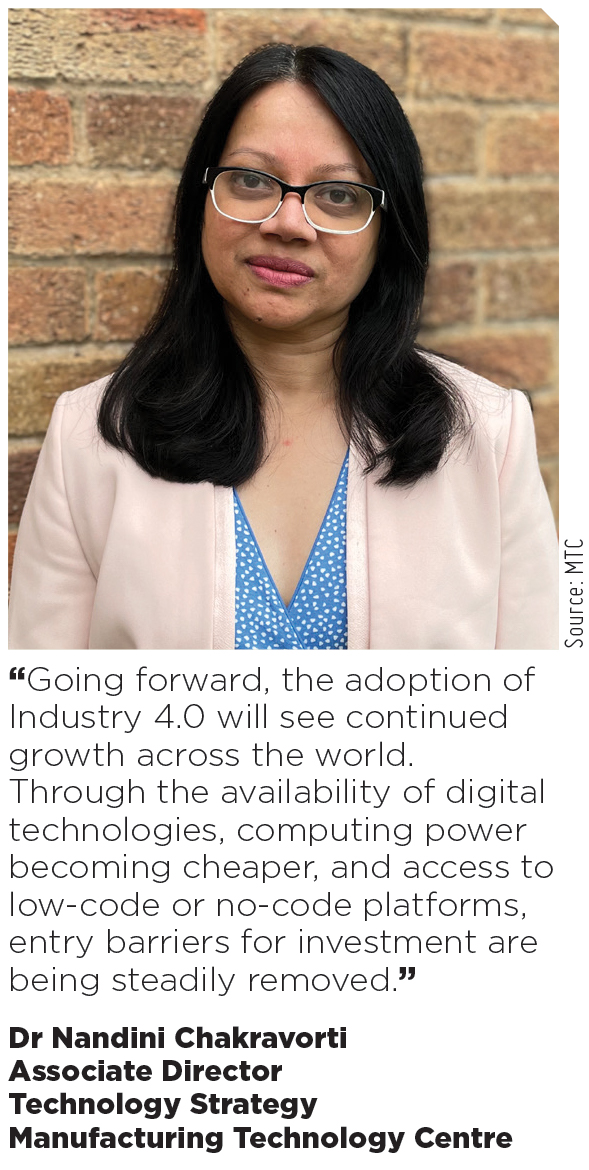BREAKING THROUGH THE GLASS CEILING

Dr Nandini Chakravorti, Associate Director, Technology Strategy, Manufacturing Technology Centre (MTC), shares her experience on the adoption of advanced manufacturing technologies and how, as a woman in engineering, she has overcome challenges, identified opportunities, and paved the way for other women to follow.
You recently addressed the audience at IMTMA’s International Seminar on Manufacturing Technology as a Chief Guest. How was your experience at the event? Did anything specifically stand out to you about how the Indian Machine Tool industry is progressing, especially with the incorporation of Smart Manufacturing?
Dr Nandini Chakravorti: Various OEMs, technology suppliers, manufacturers, and researchers from different countries were present at the event. Industrial automation, simulation tools, data analytics platforms, robotics, IoT platforms, sensors, additive manufacturing machines, and CNC machines were demonstrated by a range of technology suppliers.
The visitor profile included representatives from diverse industrial sectors, such as Aerospace and Automotive. This cross-fertilization is critical for the horizontal innovation and diffusion of industrial digital technologies within manufacturing sectors.
The availability of technology solutions needs to be accompanied by the right skills. IMTMA already provides specialized training, and this could be a potential area of collaboration with MTC.
|
Industrial shows like IMTEX 2023 are valuable for showcasing state-of-the-art technologies that are available to respond to the challenges faced within the metal-cutting machine tools industry. |
Industry 4.0 is not a new term; however, there has been an upsurge in the adoption of the same in the Machine Tool sector, especially in India. Will this now be the minimum benchmark, and what can we expect going forward?
Industry 4.0 refers to a number of technologies, including robotics, automation, additive manufacturing, industrial connectivity, cloud computing, and artificial intelligence (AI). Indian Machine Tool sector has seen an accelerated adoption of Industry 4.0, primarily due to a demand for improved productivity, increased efficiency, and enhanced quality control.
Machine Tool sector has seen an accelerated adoption of Industry 4.0, primarily due to a demand for improved productivity, increased efficiency, and enhanced quality control.
Going forward, the adoption of Industry 4.0 will see continued growth across the world. Through the availability of digital technologies, cheaper computing power, and access to low-code or no-code platforms, entry barriers for investment are being steadily removed. More demonstrable use of Industry 4.0 technologies and a clear return on investment will drive an accelerated deployment of these technologies. Product servitization, predictive maintenance schedules for production assets, digital twins of processes and facilities, and data traceability, will continue to be key trends in manufacturing.

Dr Nandini Chakravorti, Associate Director, Technology Strategy, Manufacturing Technology Centre addressing the audience at IMTMA's ISMT.
Automation and robotics seem to be the obvious step in upgrading a manufacturing process. However, a lot of companies are still wary of its incorporation. How do you see this technology impacting the sector?
Manufacturing businesses today are under constant pressure to meet customer demands for faster, better, high-quality, bespoke products that can be delivered right the first time. And introducing automation and robotics may be the solution to making productivity gains. Although automation and robotics are used for reliability and accuracy, many organizations have concerns about the incorporation of automation and robotics, specifically in justifying the upfront investment, the need for specialist skills, and the fear of jobs being displaced.
There are a number of examples where manufacturers have seen their businesses expand and become more competitive as a result of introducing robots on their shop floor. Consequently, they employ more people, and these people work on more innovation-based, value-added, and, therefore, better-paid jobs.
The impact of the adoption of such technologies will depend on how they are implemented. The best approach is to start small, focus on one process, and scale up through other processes. Robots and automation, similar to technologies such as AI, should be used where they are best suited.
How are smart manufacturing technologies such as modeling and simulation and additive manufacturing helping companies become competitive? Please share examples if possible.
Modeling and simulation is a powerful tool to boost operational efficiency, improve planning efficiency, and optimize factory layouts and the performance of businesses. MTC has been part of a collaborative project with Dowty Propellers to develop technologies within a new digital infrastructure, delivering benefits in propulsion performance and cost efficiency. Through this relationship, MTC has developed and demonstrated new smart factory concepts for more efficient production of propeller systems. The work involved the development of a discrete event simulation digital twin of the Dowty Propellers value stream to generate intelligent production schedules. https://www.the-mtc.org/case-studies/digiprop/
|
It is worth bearing in mind that with more data being available, considerations around interoperability between manufacturing systems and security (of data and systems) become more pertinent. |
Additive manufacturing (AM) is making an impact on improving product and manufacturing efficiencies. This approach to manufacturing enables more complex geometries than those achievable through conventional methods, which means parts can be redesigned to consolidate what was 10s or 100s of separate parts into one larger optimized part, such as the well-publicized examples from GE Aviation: https://am-uk.org.uk/wp-content/uploads/2018/12/GE_Additive_public_slides.pdf
- Leap fuel nozzle (20 parts to 1, 25% weight reduction, 95% inventory reduction, 30% cost efficiency improvement, 5x more durable).
- Advanced turboprop (855 parts to 12, 20% reduced fuel burn, 5% weight reduction, test schedule reduced from
12 m to 6 m)) - Catalyst engine casing (7assemblies to 1, 50 sources to 1, 300 parts to 1, 10+lbs weight reduction)
As well as optimizing the product, the manufacturing process can be dramatically simplified, requiring fewer manufacturing approaches and sources of parts, more flexible manufacturing that enables more and later design iterations, faster time to market, and supply chain resilience. While there is a significant activity to exploit the full benefits of AM on end-use parts, AM is also being used to support conventional manufacturing approaches by producing prototypes, tools, jigs, and fixtures, which are often quick wins for a company looking to benefit from AM!
The UK National Centre for AM, based at MTC, performs numerous projects each year to support companies in proving AM for their applications. Over a three-year period, MTC and Rolls-Royce collaboratively designed, set up, and operated an AM pre-production facility that supplied all of the titanium engine section stator (ESS) components required for the Ultrafan™ engine development program. Tens of thousands of equipment run hours with extensive data capture were used to gain insights for process optimization and product assurance. 240 aerospace standard components were delivered complete with full traceability for the flying test bed program. https://ncam.the-mtc.org/case-studies/aerospace-pre-production-project/
Artificial Intelligence and Machine Learning is a game changer. How do you see it impacting manufacturing in the coming years?
Artificial Intelligence (AI) and machine learning have a significant role in augmenting human operators within manufacturing. These technologies will continue to see increased use within a number of manufacturing applications, including those described below:
within a number of manufacturing applications, including those described below:
Traditional in-person inspection can be error-prone and time-consuming. Using AI for in-process inspection can reduce the time to market, enhance quality, and increase efficiency.
Using data from sensors and production equipment can optimize predictive maintenance schedules. This can be a game changer for enhancing the life of production assets and minimizing losses due to sudden equipment failures.
AI can be used for optimizing energy consumption throughout the production process and reducing greenhouse gas emissions.
How have Big Data and Digital Engineering changed the way manufacturing companies operate?
Big Data and Digital Engineering are providing a competitive advantage to several manufacturers. A few applications (not an exhaustive list) of Big Data and Digital Engineering in manufacturing industries are:
- Quality Control: Traditional in-person inspection is error-prone, time-consuming, and inconsistent. Access to data can provide predictive quality control, thus increasing the reliability and speed of inspections. Consequently, improving production efficiency and reducing time-to-market.
- Prediction of machine health and optimized maintenance schedules through the use of predictive analytics, reducing sudden downtime in production due to unplanned machine failures.
- Enhancing sustainability and reducing waste through monitoring and predicting the environmental impact of the use of production assets.
As a woman in engineering, what are the challenges you have faced in the industry? What strategies did you use to overcome these challenges?
Learning to consciously switch off from work and deliberately make choices regarding the opportunities to engage and decline is crucial. It’s important to have hobbies that keep me busy outside of work.
I consciously seek out mentors within and beyond my current organization. Building support networks within and outside the organization, e.g., being part of Women in Engineering and diversity events, is also what I engage in.
and diversity events, is also what I engage in.
Being assertive, with a clear communication style, and growing in confidence through continuous learning is essential.
Women bring a unique perspective to all fields they end up in. From experience, can you tell us how you identified opportunities and made use of them to forge your own path?
Don’t be afraid to step outside your comfort zone. For example, lead a critical project or a cross-functional team that would have a lasting impact on the business. For me personally, leading a very high-impact project, including a cross-functional team, helped me develop my leadership brand and enhance my ability to influence people at different levels within the organization.
|
AI can be used to monitor waste in manufacturing and also identify opportunities for decreasing waste in production, enabling manufacturing industries to become more environmentally friendly. |
Focus areas for women starting their careers in engineering
- Get a mentor: A mentor can advise, provide support, and signpost opportunities.
- Build your network: Connect with your peers and other professionals, attend industry events, and support other women.
- Be confident and believe in yourself: Be assertive and do not shy from voicing your opinions. Don’t become a victim of imposter syndrome.
- Define what personal and professional success means to you: This may evolve and change over time. But having deliberate goals is important.
- Keep experimenting: Don’t shy away from stepping outside your comfort zone.
- Keep developing yourself. Learning is a constant in any profession. Be that within a technical capacity or more holistic personal development, e.g., influencing and negotiating.
L-R: Rajendra Rajamane, Vice President, IMTMA; Dr Nandini Chakravorti; Ravi Raghavan, President, IMTMA; and Jibak Dasgupta, Director General & CEO, IMTMA.
Image Source: IMTMA
 |
SOUMI MITRA Editor-in-Chief Modern Manufacturing India soumi.mitra@magicwandmedia.in |




 Facebook
Facebook.png) Twitter
Twitter Linkedin
Linkedin Subscribe
Subscribe